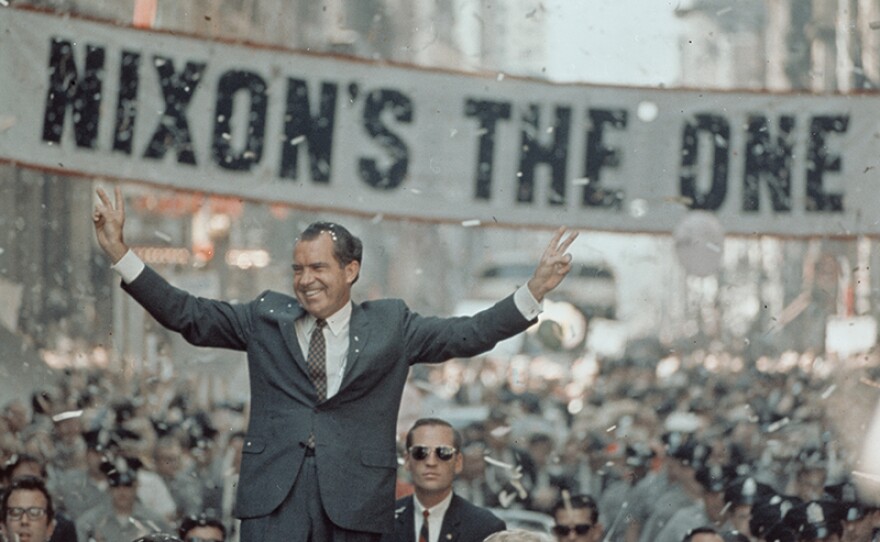Has there ever been a year like 1968?
Assassinations, racial unrest, nationwide riots, and an endless war in Vietnam put the nation on edge and produced a historic three-way presidential election where all the candidates were deeply flawed.
Backed into a corner by rising casualties in Vietnam and with no easy exit strategy, President Johnson stunned the nation in March 1968 when he announced he would not seek a second full term in the White House.
As his efforts to secure a compromise peace proved futile, LBJ's popularity plummeted further. Even darker hours came when Martin Luther King, Jr. and Robert F. Kennedy were cut down by assassins' bullets.
Ball Of Confusion: The 1968 Election Trailer
Race riots and anti-war protests erupted in hundreds of cities across the country and the world. The hostilities and bitterness spilled over onto the floor of the Democratic National Convention in Chicago where massive demonstrations and an unforgiving police response nearly tore the party apart.
The American voters faced an unwelcome but unavoidable dilemma: Could they right America's course, especially with an unsatisfying set of choices in the Nov. election for the White House?
Republican Richard Nixon, Democrat Hubert Humphrey, and Independent George Wallace were at the eye of the storm, and in some ways contributed to the intensity of the tempest.
The world watched as a fractured electorate narrowly and without evident enthusiasm chose Nixon.
In “Ball Of Confusion: The 1968 Election,” the story of 1968 and the presidential election are told through interviews with Larry J. Sabato, Ted Koppel, Skip Humphrey, Walter Mondale, Mark Updegrove, Fred Malek, George Wallace Jr. and Peggy Wallace, among others.
1 of 10
Vice President Hubert Humphrey addresses Vietnam War protesters, who believe he is a lapdog of LBJ. Most voters were completely unaware that Humphrey was opposed to Johnson's war policy in Vietnam, which put him "on the outs" with the president.
Courtesy of American Public Television
2 of 10
Hubert Humphrey campaigns with Mayor Richard Daley of Chicago. Humphrey was unexpectedly thrust into the presidential campaign after LBJ's surprise announcement that he would not run for president in 1968.
Courtesy of American Public Television
3 of 10
National Guardsmen stand outside the Conrad Hilton Hotel in Chicago, a scene of violent protests and police brutality during the 1968 Democratic National Convention.
Courtesy of American Public Television
4 of 10
Anna Chennault, was accused of thwarting the Paris Peace talks between Lyndon Johnson and the North and South Vietnamese, on the behalf of the Nixon campaign.
Courtesy of American Public Television
5 of 10
LBJ informs presidential candidate Nixon about certain matters he could face as president. LBJ had similar conversations with other presidential candidates.
Courtesy of American Public Television
6 of 10
Nixon and Vice Presidential candidate Spiro Agnew at the Republican National Convention in Miami Beach, Florida. Agnew's poor political skills and insensitive comments had a negative effect on the Nixon campaign.
Courtesy of American Public Television
7 of 10
After a public break with Johnson on the Vietnam War policy, Humphrey saw his poll numbers rise to the point where a presidential win looked probable.
Courtesy of American Public Television
8 of 10
George Wallace had the largest turnout for a third part candidate in a presidential election before or since 1968.
Courtesy of American Public Television
9 of 10
Gov. George Wallace, known as a southern segregationist, campaigns with his daughter Peggy in the Northeast, where he drew both sharp criticism and surprisingly large crowds of blue collar supporters.
Courtesy of American Public Television
10 of 10
"Nixon's The One" campaign slogan banner hangs behind the candidate during a campaign rally.
Courtesy of American Public Television
Credits:
Produced by WCVE and University of Virginia Center for Politics. Distributed by American Public Television.
















